#Swiftgron x mainstream
Explore tagged Tumblr posts
Text

Happy Pride!!!
#Swiftgron 2023#Swiftgron x Rollingstone#Swiftgron x mainstream#dianna agron x gaylor swift#Rollingstone 2023 interview
7 notes
·
View notes
Text
late stage swiftgron - the folklore era - 1.0
this post will include all relevant and major activities between taylor and dianna since taylor announced folklore on the morning of July 23, 2020.
click here for a dianna’s spotify masterpost (we are only including the most loud spotify activities on this post but it’s all very interesting)
tagging @jennyboom21, @goldenageofsomethingblue, and @tayloragron to help me out if i miss something (and ofc all of you swiftgrons who help out with the blog, don’t hesitate to let me know if i miss something major)
JULY 23, 2020
- 8 AM EASTERN - TAYLOR ANNOUNCES FOLKLORE TO COME OUT AT MIDNIGHT
- THAT AFTERNOON - DIANNA UPLOADS A NEW PLAYLIST TO SPOTIFY ENTITLED I’LL BE AROUND, WITH ONE SONG ON IT - ‘I’LL BE AROUND’ BY FLOOR CRY:
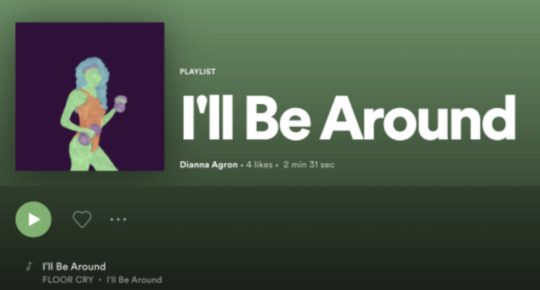
- DIANNA ALSO STREAMS THE SONG ‘I LOVE YOU SO’ BY THE WALTERS:

this song contains a very loud lyric that makes us believe ‘the 1′ is about dianna:
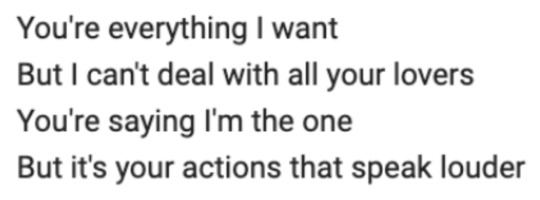
JULY 24, 2020
- MIDNIGHT - FOLKLORE COMES OUT
- SOME TIME THAT AFTERNOON - DIANNA ATTENDS NAYA RIVERA’S FUNERAL IN LA
JULY 25, 2020
- AFTERNOON - DIANNA TURNS OFF HER SPOTIFY LISTENING FOR THE REST OF THE DAY AND INTO THE NEXT DAY (WE THEORIZE TO LISTEN TO FOLKLORE)
- DIANNA’S SOON TO BE EX HUSBAND, WINSTON MARSHALL, POSTS THIS SHADY ASS PIC TO INSTAGRAM WITH THE CARDIGAN LYRICS WHILE HE PLAYS A BOARD GAME WITH HIS BAND MATE
JULY 29, 2020
- DIANNA POSTS A LOUDLY DOLLY BIRTHDAY POST FOR MOLLY’S BIRTHDAY
- TAYLOR RELEASES THE “cabin in candlelight” VERSION OF CARDIGAN
JULY 30, 2020
- DIANNA IS RATHER ACTIVE ON SPOTIFY INCLUDING A STREAM OF ‘HAPPY TOGETHER’ COVERED BY FLOOR CRY WHICH SEEMS TO BE A DOLLY SONG (there is a very cute video of them goofing around on a beach, pretending to make out, being very adorable and affectionate with each other - dianna posted it and specifically edited it to add the song happy together)
- THE BLOG GETS AN ANON REMINDING US HOW DIANNA WOULD LISTEN TO PALE BLUE EYES BY THE VELVET UNDERGROUND AROUND THE TIME SWIFTGRON WAS BREAKING UP IN 2013, WE PUBLISH AND DISCUSS ON MAIN
AUGUST 4, 2020
- DIANNA STREAMS PALE BLUE EYES BY VELVET UNDERGROUND ON HER PUBLIC SPOTIFY 5 DAYS WE DISCUSSED HER LISTENING TO THAT SONG IN 2013 HERE ON THE BLOG
- TAYLOR IS SPOTTED IN CAPE COD
AUGUST 5, 2020
- TAYLOR NO-HOMO’S BETTY ON COUNTRY RADIO
- DIANNA STREAMS PALE BLUE EYES AGAIN
AUGUST 6, 2020
- KEVIN TEASES SWIFTGRON ON SHOWMANCE AND TALKS ABOUT TAYLOR LOOKING FOR SOMEONE (LIKELY DIANNA) ON THE GLEE SET IN FEBRUARY OR MARCH 2014, POSSIBLY CONFIRMING THAT SWIFTGRON PINING WENT ON LONGER THAN WE EARLIER THOUGHT
- TAYLOR IS SPOTTED BRIEFLY IN LA WITH JOE
AUGUST 8, 2020
- DIANNA IS CONFIRMED TO BE BACK IN NYC
AUGUST 9, 2020
- DIANNA TRULY SNAPS, CRAVES WET PUSSY ON MAIN IN THE PLATFORM PRESENTS EDWARD SNOWDEN SKIT. WE LIKE TO PRETEND THAT SHE DID THIS TO MAKE UP FOR TAYLOR’S NO-HOMO OF BETTY
AUGUST 15, 2020
- BOTH OUR GIRLS POST TO SOCIAL MEDIA ABOUT SUPPORTING THE USPS WITHIN THE SAME HOUR
- DIANNA IS ON A FRIEND’S SOCIAL MEDIA IN CONNECTICUT
AUGUST 18, 2020
- THE LAKES (WHICH IS A SONG ABOUT TAYLOR WAITING FOR HER MUSE) AND THE DELUXE VERSION OF FOLKLORE COMES OUT
- TAYLOR DISCUSSES THE MEANING BEHIND EXILE ON RADIO
AUGUST 19, 2020
- DIANNA’S DIVORCE IS ANNOUNCED AROUND 8 AM EASTERN TIME
AUGUST 20, 2020
- ESCAPISM FOLKLORE CHAPTER RELEASED
AUGUST 21, 2020
- DIANNA IS SPOTTED IN NYC WITH HER HAIR CUT AND FRESHLY DYED
- DIANNA GAY RUMORS SWIRL AS WELL AS HER CONNECTION TO TAYLOR, IT ALL SEEMS TO BE PICKING UP STEAM, THE BLOG PREDICTS A JOE x TAYLOR STUNT
- DIANNA’S WIKIPEDIA PAGE IS EDITED, A MORE FEMININE PICTURE IS MADE HER MAIN PICTURE, SEVERAL PEOPLE ARE EDITING HER PERSONAL LIFE SECTION. SWIFTGRON RUMORS ARE ADDED TO IT:

IT APPEARS AS THOUGH A USER GOING BY KINGSIF MAKES THESE EDITS:

AUGUST *22*, 2020
- IT IS ONE OF DIANNA’S GOOD FRIEND’S, SELBY’S BIRTHDAY. SELBY (WHO WAS AT THE FUN CONCERT IN FALL 2013) POSTS TO INSTAGRAM WITH BOTH MTR AND WILDEST DREAMS PLAYING IN THE BACKGROUND. DIANNA DOES NOT PUBLICLY WISH HER A HAPPY BIRTHDAY (tho she didn’t post for selby’s birthday last year, however she didn’t like molly’s selby birthday dedication and she usually does comment on posts molly has made for selby’s birthday or like it or both in the past, she also didn’t comment on or like tracy dubb’s selby birthday post)
AUGUST 23, 2020
- SLEEPLESS NIGHTS FOLKLORE CHAPTER RELEASED
AUGUST 24, 2020
- DIANNA IS IN CHILMARK, MA AT A LAKE WITH FRIENDS (it’s probably a coincidence but this location is not too far a drive or ferry ride from taylor’s place - about an hour)
AUGUST 25, 2020
- DIANNA IS HAPPY AND FRESH AND CUTE ON THE SHIVA BABY LIVE STREAM
AUGUST 26, 2020
- SALTBOX FOLKLORE CHAPTER RELEASE
- THE BLOG POSTS THE SPOTIFY SINCE FOLKLORE MASTERPOST
- A FEW HOURS LATER SPOTIFY GLITCHES AND/OR DIANNA GOES PRIVATE ON SPOTIFY, IT IS HARD TO TELL WHICH HAPPENED OR IF BOTH THINGS HAPPENED. SHE DOESN’T STREAM AGAIN UNTIL 9/2/2020
- DIANNA IS PAPPED IN NYC CARRYING A BOOK DESCRIBED AS RAUNCHY AND QUEER LMAO
- DIANNA SHOWS UP IN INSTAGRAM STORIES OF SOMEONE WEARING A MASK AND A DETROIT BLOWS SHIRT
AUGUST 28, 2020
- DIANNA SHOWS UP IN A DOG’S INSTAGRAM POSTS, RARE BTS FOOTAGE OF HER IN HER AMAZING ROMEO DRAG FOR HER ROMEO AND JULIET PHOTOSHOOT FROM 2019
- TAYLOR NATION POSTS A PICTURE OF TAYLOR WITH WINE FROM THE FOLKLORE LIVE CHAT THAT TOOK PLACE THE EVENING OF THE 23RD RIGHT BEFORE FOLKLORE DROPPED TO CELEBRATE NATIONAL *RED* WINE DAY
AUGUST 29, 2020
- DIANNA’S INVOLVEMENT IN A PLAY OR FILM ADAPTATION OF A TALE OF TWO CITIES GOES PUBLIC ON INSABELLA MACPHERSON’S INSTAGRAM. THE QUOTE REFERENCED IS, “IT WAS THE BEST OF TIMES IT WAS THE WORST OF TIMES”
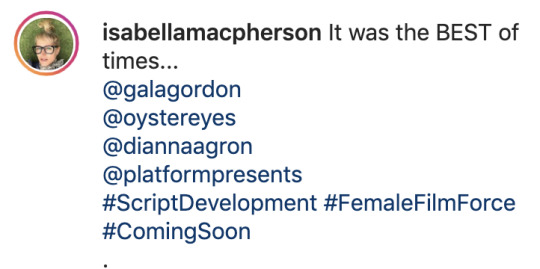
- THE OSSA YOUTUBE CHANNEL SNAPS AND SENDS SWIFTGRON MAINSTREAM SHOWING THAT NO, THEY’RE NOT OVER SWIFTGRON SO WHY SHOULD WE BE OVER IT? THEY ADD SWIFTGRON RUMORS TO A VIDEO TALKING ABOUT WHO ALL THE GLEE CAST HAS DATED.
as of 9-4-2020 9 am central this video now has 115 k views:

AUGUST 30, 2020
- DIANNA’S OLD BOSS RYAN MURPHY FOLLOWS TAYLOR ON INSTAGRAM, MAKING HER THE 13TH PERSON HE FOLLOWS (we speculate that taylor’s music will be featured on his upcoming movie, the prom)
- TAYLOR WINS VMA FOR BEST DIRECTION FOR THE MAN, SHE GIVES A DIGITAL ACCEPTANCE SPEECH AND ENDS IT WITH A TENDER “I HOPE I GET TO SEE YOU SOON.”
AUGUST 31, 2020
- THE BLOG REQUESTS DIANNA TO COME BACK TO SPOTIFY:
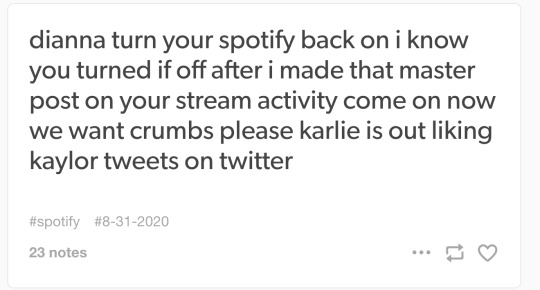
SEPTEMBER 2, 2020
- DIANNA COMES BACK TO SPOTIFY WITH TWO VERY INTERESTING PLAYLISTS (songs that seem to specifically and blatantly reference taylor’s lyrics)
SEPTEMBER 3, 2020
- DIANNA PAPPED IN NYC OUT BOOK SHOPPING
SEPTEMBER 4, 2020
- CAM SNAPS AND DECIDES TO CELEBRATE THE FAIRFAX FLEA MARKET ANNIVERSARY BY MAKING THIS MASTERPOST. HAPPY SWIFTGRONTEMBER.
what does it all mean?
as you all know, this blog does not think swiftgron is together (other than being friendly and on cordial or even close terms) however we do think swiftgron is being referenced by kevin, her wikipedia, and that news video as part of a narrative. we are not entirely sure what that narrative is but we have two very specific ideas. if you hang around the blog or discord you probably know what our two theories are. we are not comfortable blogging them publicly right now.
the usps post coordination is very loud to us as well along with the outside sources commenting on swiftgron.
it is not just our small circle of delulu 2020 swiftgrons that notice something going on with the girls. they are referencing each other and seem to be circling one another and normal people are taking note.
i probably missed a lot so please ping me if i did (esp about taylor, we don’t track her as closely as we do dianna, we’re going to start though) and please read over this post with big swiftgron intelligence agency eyes 👀👀👀! if there are connections and “coincidences” that stand out to you anon the blog or comment please!
and that’s what you missed on swiftgron
76 notes
·
View notes
Text
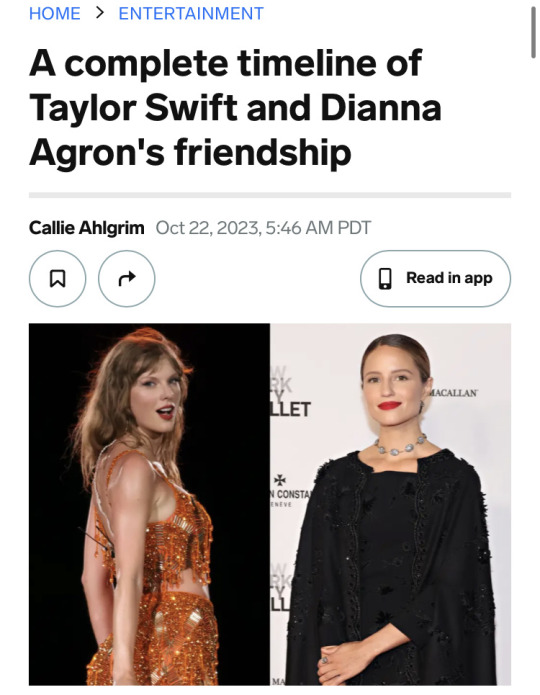

Before Taylor Swift was sparking headlines about "squad goals" or attracting throngs of Hollywood stars to The Eras Tour, she and Dianna Agron were nearly inseparable.
The "Style" singer and "Glee" star became close in 2012 and were quickly identified in the media as "blonde BFFs." However, the following year, Swift and Agron suddenly seemed to lose touch. They haven't been spotted together since 2014.
Keep scrolling to see everything we know about the once-close pair.
They became friends while Swift was working on 'Red'
It's unclear how and when Swift and Agron met. In 2010 and 2011, Swift became friendly with "Glee" stars like Cory Monteith and Chord Overstreet, so it's possible the women were introduced by Agron's castmates. They both attended the 2011 Vanity Fair Oscar Party, but there's no evidence they interacted.
Swift and Agron were spotted in public for the first time on September 4, 2011 at a flea market in Los Angeles. Swift was between shows on the Speak Now World Tour, while Agron had recently wrapped a series of Glee Live! concerts.
By this time, we know that Swift was in the process of creating her fourth album because she had already written "All Too Well."
According to her diary excerpts (released alongside "Lover" in 2019), the beloved song was conceived in February 2011. She decided to name the album "Red" in September 2011.
Dianna Agron and Taylor Swift in 2012.
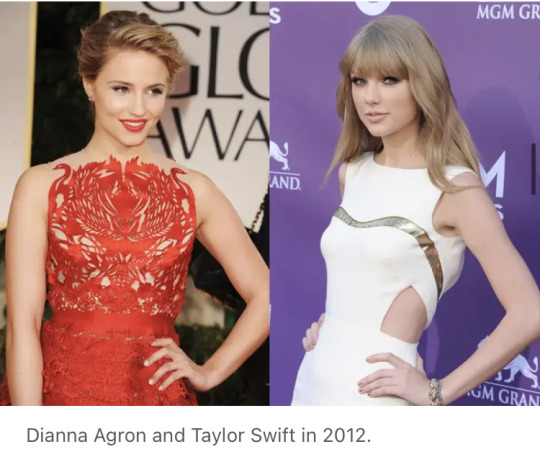
January 7, 2012: Agron tweeted that Swift looked 'beautiful' on the cover of Vogue
Swift was photographed by Mario Testino for the February 2012 issue of Vogue, for which she was given retro-style bangs. According to a behind-the-scenes video, the photoshoot took place on the eve of her 22nd birthday.
"Taylor looks all kinds of 70's beautiful....and love a hat! Great job," Agron wrote on Twitter, tagging both Vogue and Swift.
March 25, 2012: Swift and Agron went to see 'The Hunger Games' together
A group of fans snapped a photo with Swift and Agron at the theater during the movie's opening weekend.
April 12, 2012: Agron shut down rumors that she was in a 'love triangle' with Swift and Tim Tebow
For some reason, in early 2012, tabloids ran wild with a theory that Agron was dating NFL quarterback Tim Tebow while Swift was harboring a "puppy dog" crush on him.
During an appearance on "Jimmy Kimmel Live," Agron quashed the rumors. She clarified that she had a "10-minute chat" with Tebow and hadn't seen him since.
Kimmel also asked her to address her relationship with Swift: "Are you dating her? That would be great."
"Wouldn't that be juicy?" Agron replied, blowing a kiss to the camera and adding, "Hi Taylor."
April 24, 2012: They wore vintage gowns and flower crowns to celebrate Shirley MacLaine's birthday
Swift, who costarred with MacLaine in the 2010 film "Valentine's Day," played dress-up with Agron and two more friends in honor of the actor's 78th birthday. The small group shared photos of the occasion on social media, though most have since been deleted.
"We dressed up full-time fancy and went out in celebration of Shirley MacLaine's birthday," Swift wrote on Twitter, per E! News.
"Had a long day & don't know what to celebrate later…? Because you need a moment to be young? Find your moments," Agron added in her own tweet.
April 28, 2012: Swift celebrated Agron's 26th birthday
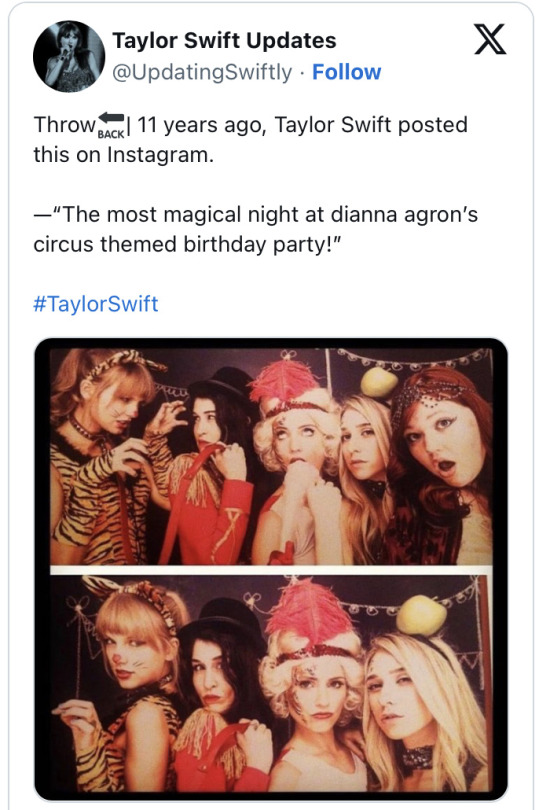
Swift wore a tiger costume for Agron's circus-themed birthday party, which she called "the most magical night" on Twitter.
"The blonde BFFs have been spending a lot of time together as of late," E! News wrote.
May 15, 2012: They dined together in Los Angeles
Paparazzi caught Swift and Agron leaving Dominick's, an Italian restaurant in West Hollywood, after a Tuesday night dinner.
July 4, 2012: Swift and Agron spent the holiday in Hyannis Port, Massachusetts
Swift was spotted in the famous East Coast town during Fourth of July weekend, mostly hanging out at the Kennedy compound. She was accompanied by Agron and their friend Claire Kislinger (neé Winter), according to the Boston Herald and Us Weekly.
Kerry Townsend, the granddaughter of Ethel Kennedy, tweeted at the time: "Arrived at my Grandma's house to find her chilling with Taylor Swift and Dianna Agron. I hope I'm this cool when I'm 83!"
October 22, 2012: Swift released 'Red,' which includes a dedication to Agron
Swift is known for leaving coded messages for fans in the liner notes of her album. The secret message for "22" was four names: "Ashley Dianna Claire Selena."
In addition to Agron and Kislinger, these most likely refer to stylist Ashley Avignone and Selena Gomez. The song is about spending a carefree night with friends, though hints of ill-advised romance are sprinkled in: "You look like bad news / I gotta have you."
There could be another reference to Agron in the liner notes for "Everything Has Changed." The song's secret message is "Hyannis Port," where Swift spent some time with green-eyed Conor Kennedy that summer. ("All I've seen since 18 hours ago / Is green eyes and freckles and your smile," Swift sings.)
However, many fans have noticed that "Hyannis Port" is actually misspelled in the liner notes as "Hyiannis Port," which mirrors the spelling of Dianna (who also has green eyes).
The day that "Red" was released, Agron congratulated Swift on Twitter with a screenshot of her phone playing "Everything Has Changed."
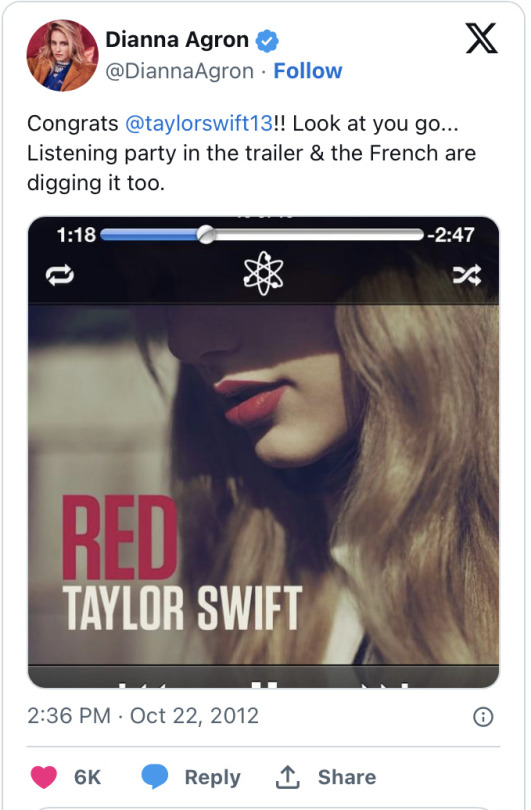
December 3, 2012: Swift and Agron both attended the Ripple of Hope gala
Swift and Conor Kennedy reportedly split in October 2012 after a few months of dating. However, later that year, Swift was still honored with the Ripple of Hope Award from the Robert F. Kennedy Center for Justice & Human Rights.
The annual gala was held at the Mariott Marquis in New York City. According to E! News, Swift had Agron "by her side" throughout the event. She also performed "Starlight," a song from "Red" that was inspired by Ethel and Bobby Kennedy.
"Was a beautiful night last night. The RFK foundation provides help to so many truly deserving," Agron tweeted. "Plus @taylorswift13 was truly lovely."
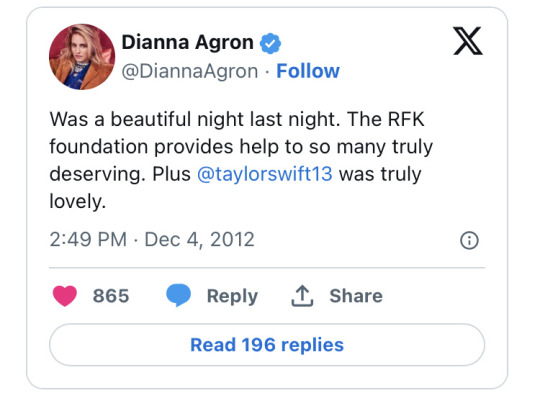
April 2013: A fake artice, which claimed Swift and Agron were dating, went semi-viral
Shortly after Swift embarked on the Red Tour, a doctored screenshot from a fake tabloid began circulating on Twitter. The headline from Stars Daily, which does not exist, said "Taylor Swift is in a new relationship...but it's not what you expected."
"Country pop singer Taylor Swift has confirmed being in a relationship with Glee star Dianna Agron," the fake article continued. "Lesbi-honest! Right after the rumors were confirmed, the two were spotted out on a dinner date." (The attached photo was from Swift and Agron's dinner at Dominick's in 2012.)
On April 23, 2013, "Skins" actor Dakota Blue Richards tweeted about the rumor: "So apparently Taylor Swift and Dianna Agron are dating. Sorry Brangelina, you just got taken over as the worlds hottest couple."
Neither Swift nor Agron publicly responded to the rumor. But Richards' reaction seemed to increase its virality, and the following day, Agron deleted her Tumblr.
"Thank you friends for following the journey," she wrote in her final post. "But as an old chapter closes, a new chapter begins."
September 4, 2013: Swift, Agron, and other friends went to a Fun. concert
"Modern Family" star Sarah Hyland shared a video from backstage at the Fun. concert, which took place at the Greek in Los Angeles. Swift is featured in the short clip, while Agron is briefly shown standing off to the side.
"Watching @OurNameIsFun live tonight at the Greek was unforgettable," Swift wrote on Twitter, per Taste of Country. "Such incredible musicians and showmen. It was just SO good."
Two days later, Agron also tweeted an inside joke about the concert, tagging Swift.
This seemed to be the last time they intentionally hung out (at least in public).
October 27, 2014: Swift released the deluxe version of '1989,' which includes a breakup song called 'Wonderland'
The lyrics of "Wonderland" clearly reference "Alice's Adventures in Wonderland," the 1865 novel by Lewis Carroll. When Swift performed the "1989" deluxe track as a surprise song on The Eras Tour, she said it was a "twisted" take on the fairy tale.
In the song, Swift describes her muse as having green eyes and a "Cheshire Cat smile." She says they "fell down the rabbit hole" and got lost in Wonderland, all without considering the consequences.
"Haven't you heard what becomes of curious minds?" she sings in the pre-chorus, a reference to Alice's observation that "curiosity often leads to trouble."
Swift concludes in the bridge: "In the end, in Wonderland / We both went mad."
Some fans have drawn a connection between "Wonderland" and Agron, who has repeatedly tweeted about her love for Alice.
"I love 'Alice in Wonderland' and 'The Hobbit,'" Agron said in a 2011 interview with Elle. "Those books got me into reading and storytelling — I could escape to a different world."
Indeed, Agron reportedly had a Tumblr, deleted in 2013, that was called "felldowntherabbithole."
She also had a reference to "Alice's Adventures in Wonderland" tattooed on her ribcage: "We're all mad here," which is a quote from the Cheshire Cat. Fans noticed that Agron was in the process of removing her tattoo in 2017.
November 23, 2014: They had a brief interaction at the 2014 American Music Awards
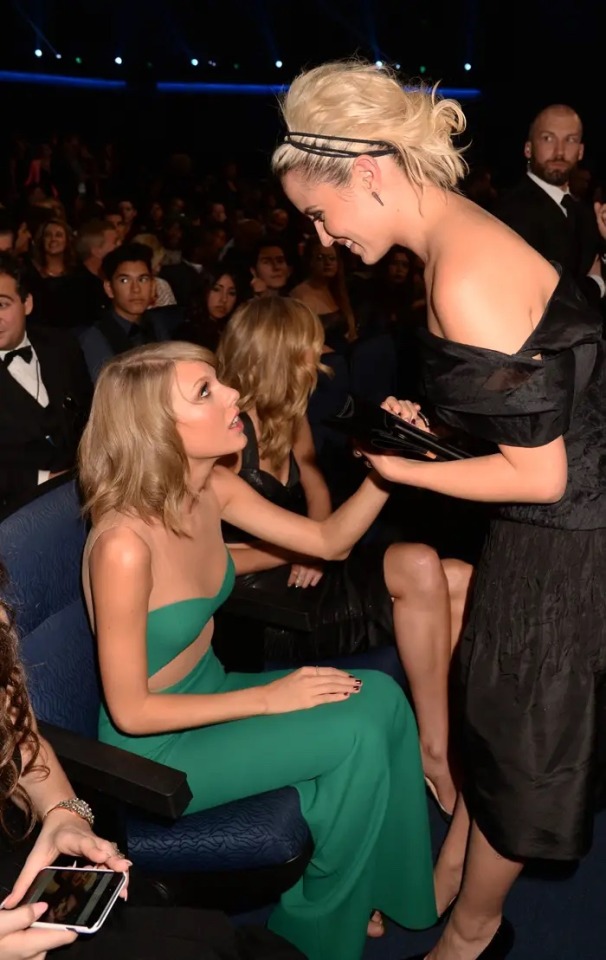
Although she spent most of the evening with Karlie Kloss, photographers did catch Swift having a moment with Agron at the 2014 AMAs, where she also performed her single "Blank Space."
This was the last time Swift and Agron were seen together in public. Notably, Agron did not appear among Swift's many celebrity friends in the 2015 "Bad Blood" music video, which seemed to confirm they were no longer close.
October 5, 2019: Agron went to 'SNL' when Swift was the musical guest
Agron was photographed leaving 30 Rock after "Saturday Night Live" finished filming. Swift was that night's musical guest — she performed "False God" and the title track from "Lover" — but there's no evidence she interacted with Agron inside.
May 7, 2023: Agron was asked about rumors that she and Swift were 'in a relationship'
During an interview with Rolling Stone, Agron was asked about her influence on Swift's music, specifically "22."
"Me? Oh, if only! That's more because of a friendship than being the inspiration for the song," she replied. "But I would not be the person to ask about that. I cannot claim that!"
The reporter also asked how Agron felt about being "shipped" with Swift, which he explained as, "You two were made out by the media and some fans to be in a relationship."
In response, Agron described the speculation as "so interesting."
"I… I mean, there have been many stories about my dating life that are so wildly untrue. That's funny," she said.
#Swiftgron x msm mention#gaylor swift x dianna agron#mainstream media x Swiftgron#Swiftgron 2023#Swiftgron 2012#Swiftgron 2013#Swiftgron 2014
44 notes
·
View notes
Text
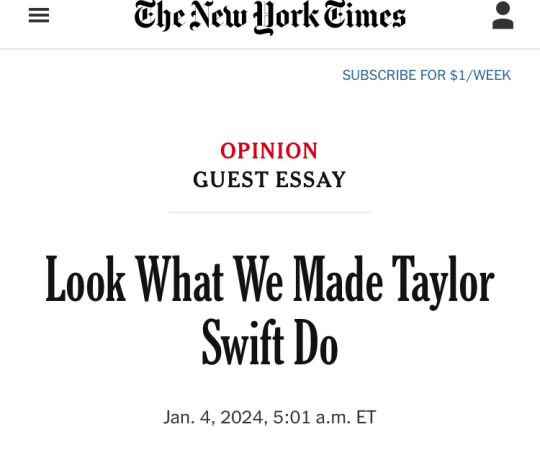
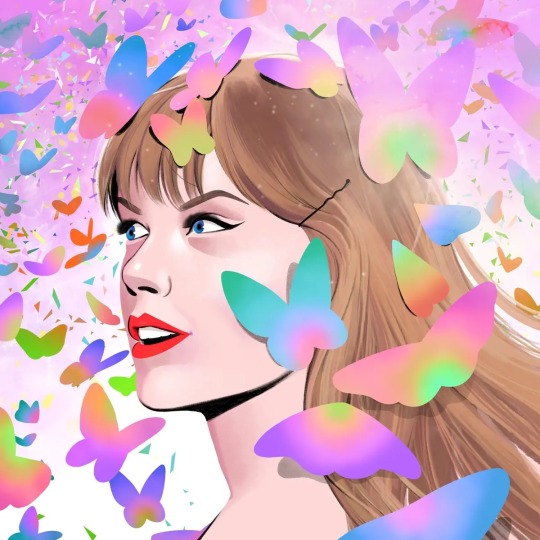
In 2006, the year Taylor Swift released her first single, a closeted country singer named Chely Wright, then 35, held a 9-millimeter pistol to her mouth. Queer identity was still taboo enough in mainstream America that speaking about her love for another woman would have spelled the end of a country music career. But in suppressing her identity, Ms. Wright had risked her life.
In 2010, she came out to the public, releasing a confessional memoir, “Like Me,” in which she wrote that country music was characterized by culturally enforced closeting, where queer stars would be seen as unworthy of investment unless they lied about their lives. “Country music,” she wrote, “is like the military — don’t ask, don’t tell.”
The culture in which Ms. Wright picked up that gun — the same one in which Ms. Swift first became a star — was stunningly different from today’s. It’s dizzying to think about the strides that have been made in Americans’ acceptance of the L.G.B.T.Q. community over the past decade: marriage equality, queer themes dominating teen entertainment, anti-discrimination laws in housing and, for now, in the workplace. But in recent years, a steady drip of now-out stars — Cara Delevingne, Colton Haynes, Elliot Page, Kristen Stewart, Raven-Symoné and Sam Smith among them — have disclosed that they had been encouraged to suppress their queerness in order to market projects or remain bankable.
The culture of country music hasn’t changed so much that homophobia is gone. Just this past summer, Adam Mac, an openly gay country artist, was shamed out of playing at a festival in his hometown because of his sexual orientation. In September, the singer Maren Morris stepped away from country music; she said she did so in part because of the industry’s lingering anti-queerness. If country music hasn’t changed enough, what’s to say that the larger entertainment industry — and, by extension, our broader culture — has?
Periodically, I return to a video, recorded by a shaky hand more than a decade ago, of Ms. Wright answering questions at a Borders bookstore about her coming out. She likens closeted stardom to a blender, an “insane” and “inhumane” heteronormative machine in which queer artists are chewed to bits.
“It’s going to keep going,” Ms. Wright says, “until someone who has something to lose stands up and just says ‘I’m gay.’ Somebody big.” She continues: “We need our heroes.”
What if someone had already tried, at least once, to change the culture by becoming such a hero? What if, because our culture had yet to come to terms with homophobia, it wasn’t ready for her?
What if that hero’s name was Taylor Alison Swift?
In the world of Taylor Swift, the start of a new “era” means the release of new art (an album and the paratexts — music videos, promotional ephemera, narratives — that supplement it) and a wholesale remaking of the aesthetics that will accompany its promotion, release and memorializing. In recent years, Ms. Swift has dominated pop culture to such a degree that these transformations often end up altering American culture in the process.
In 2019, she was set to release a new album, “Lover,” the first since she left Big Machine Records, her old Nashville-based label, which she has since said limited her creative freedom. The aesthetic of what would be known as the “Lover Era” emerged as rainbows, butterflies and pastel shades of blue, purple and pink, colors that subtly evoke the bisexual pride flag.
On April 26, Lesbian Visibility Day, Ms. Swift released the album’s lead single, “ME!,” in which she sings about self-love and self-acceptance. She co-directed a campy music video to accompany it, which she would later describe as depicting “everything that makes me, me.” It features Ms. Swift dancing at a pride parade, dripping in rainbow paint and turning down a man’s marriage proposal in exchange for a … pussy cat.
At the end of June, the L.G.B.T.Q. community would celebrate the 50th anniversary of the Stonewall Riots. On June 14, Ms. Swift released the video for her attempt at a pride anthem, “You Need to Calm Down,” in which she and an army of queer celebrities from across generations — the “Queer Eye” hosts, Ellen DeGeneres, Billy Porter, Hayley Kiyoko, to name a few — resist homophobia by living openly. Ms. Swift sings that outrage against queer visibility is a waste of time and energy: “Why are you mad, when you could be GLAAD?”
The video ends with a plea: “Let’s show our pride by demanding that, on a national level, our laws truly treat all of our citizens equally.” Many, in the press and otherwise, saw the video as, at best, a misguided attempt at allyship and, at worst, a straight woman co-opting queer aesthetics and narratives to promote a commercial product.
Then, Ms. Swift performed “Shake It Off” as a surprise for patrons at the Stonewall Inn. Rumors — that were, perhaps, little more than fantasies — swirled in the queerer corners of her fandom, stoked by a suggestive post by the fashion designer Christian Siriano. Would Ms. Swift attend New York City’s WorldPride march on June 30? Would she wear a dress spun from a rainbow? Would she give a speech? If she did, what would she declare about herself?
The Sunday of the march, those fantasies stopped. She announced that the music executive Scooter Braun, who she described as an “incessant, manipulative” bully, had purchased her masters, the lucrative original recordings of her work.
Ms. Swift’s “Lover” was the first record that she created with nearly unchecked creative freedom. Lacking her old label’s constraints, she specifically chose to feature activism for and the aesthetics of the L.G.B.T.Q. community in her confessional, self-expressive art. Even before the sale of her masters, she appeared to be stepping into a new identity — not just an aesthetic — that was distinct from that associated with her past six albums.
When looking back on the artifacts of the months before that album’s release, any close reader of Ms. Swift has a choice. We can consider the album’s aesthetics and activism as performative allyship, as they were largely considered to be at the time. Or we can ask a question, knowing full well that we may never learn the answer: What if the “Lover Era” was merely Ms. Swift’s attempt to douse her work — and herself — in rainbows, as so many baby queers feel compelled to do as they come out to the world?
There’s no way of knowing what could have happened if Ms. Swift’s masters hadn’t been sold. All we know is what happened next. In early August, Ms. Swift posted a rainbow-glazed photo of a series of friendship bracelets, one of which says “PROUD” with beads in the color of the bisexual pride flag. Queer people recognize that this word, deployed this way, typically means that someone is proud of their own identity. But the public did not widely view this as Ms. Swift’s coming out.
Then, Vogue released an interview with Ms. Swift that had been conducted in early June. When discussing her motivations for releasing “You Need to Calm Down,” Ms. Swift said, “Rights are being stripped from basically everyone who isn’t a straight white cisgender male.” She continued: “I didn’t realize until recently that I could advocate for a community that I’m not a part of.” That statement suggests that Ms. Swift did not, in early June, consider herself part of the L.G.B.T.Q. community; it does not illuminate whether that is because she was a straight, cis ally or because she was stuck in the shadowy, solitary recesses of the closet.
On Aug. 22, Ms. Swift publicly committed herself to the as-of-then-unproven project of rerecording and rereleasing her first six albums. The next day, she finally released “Lover,” which raises more questions than it answers. Why does she have to keep secrets just to keep her muse, as all her fans still sing-scream on ���Cruel Summer”? About what are the “hundred thrown-out speeches I almost said to you,” in her chronicle of self-doubt, “The Archer,” if not her identity? And what could the album’s closing words, which come at the conclusion of “Daylight,” a song about stepping out of a 20-year darkness and choosing to “let it go,” possibly signal?
I want to be defined by the things that I love,
Not the things I hate,
Not the things that I’m afraid of, I’m afraid of,
Not the things that haunt me in the middle of the night,
I just think that,
You are what you love.
The first time I viewed “Lover” through the prism of queerness, I felt delirious, almost insane. I kept wondering whether what I was perceiving in her work was truly there or if it was merely a mirage, born of earnest projection.
My longtime reading of Ms. Swift’s celebrity — like that of a majority of her fan base — had been stuck in the lingering assumptions left by a period that began more than a decade and a half ago, when a girl with an overexaggerated twang, Shirley Temple curls and Georgia stars in her eyes became famous. Then, she presented as all that was to be expected of a young starlet: attractive yet virginal, knowing yet naïve, not talented enough to be formidable, not commanding enough to be threatening, confessional, eager to please. Her songs earnestly depicted the fantasies of a girl raised in a traditional culture: high school crushes and backwoods drives, princelings and wedding rings, declarations of love that climax only in a kiss — ideally in the pouring rain.
When Ms. Swift was trying to sell albums in that late-2000s media environment, her songwriting didn’t match the image of a sex object, the usual role reserved for female celebrities in our culture. Instead, the story the public told about her was that she laundered her affection to a litter of promising grown men, in exchange for songwriting inspiration. A young Ms. Swift contributed to this narrative by hiding easy-to-decode clues in liner notes that suggested a certain someone was her songs’ inspiration (“SAM SAM SAM SAM SAM SAM,” “ADAM,” “TAY”) or calling out an ex-boyfriend on the “Ellen” show and “Saturday Night Live.” Despite the expansive storytelling in Ms. Swift’s early records, her public image often cast a man’s interest as her greatest ambition.
As Ms. Swift’s career progressed, she began to remake that image: changing her style and presentation, leaving country music for pop and moving from Nashville to New York. By 2019, her celebrity no longer reflected traditional culture; it had instead become a girlboss-y mirror for another dominant culture — that of white, cosmopolitan, neoliberal America.
But in every incarnation, the public has largely seen those songs — especially those for which she doesn’t directly state her inspiration — as cantos about her most recent heterosexual love, whether that idea is substantiated by evidence or not. A large portion of her base still relishes debating what might have happened with the gentleman caller who supposedly inspired her latest album. Feverish discussions of her escapades with the latest yassified London Boy or mustachioed Mr. Americana fuel the tabloid press — and, embarrassingly, much of traditional media — that courts fan engagement by relentlessly, unquestioningly chronicling Ms. Swift’s love life.
Even in 2023, public discussion about the romantic entanglements of Ms. Swift, 34, presumes that the right man will “finally” mean the end of her persistent husbandlessness and childlessness. Whatever you make of Ms. Swift’s extracurricular activities involving a certain football star (romance for the ages? strategic brand partnership? performance art for entertainment’s sake?), the public’s obsession with the relationship has been attention-grabbing, if not lucrative, for all parties, while reinforcing a story that America has long loved to tell about Ms. Swift, and by extension, itself.
Because Ms. Swift hasn’t undeniably subverted our culture’s traditional expectations, she has managed, in an increasingly fractured cultural environment, to simultaneously capture two dominant cultures — traditional and cosmopolitan. To maintain the stranglehold she has on pop culture, Ms. Swift must continue to tell a story that those audiences expect to consume; she falls in love with a man or she gets revenge. As a result, her confessional songs languish in a place of presumed stasis; even as their meaning has grown deeper and their craft more intricate, a substantial portion of her audience’s understanding of them remains wedded to the same old narratives.
But if interpretations of Ms. Swift’s art often languish in stasis, so do the millions upon millions of people who love to play with the dollhouse she has constructed for them. Her dominance in pop culture and the success of her business have given her the rare ability to influence not only her industry but also the worldview of a substantial portion of America. How might her industry, our culture and we, ourselves, change if we made space for Ms. Swift to burn that dollhouse to the ground?
Anyone considering the whole of Ms. Swift’s artistry — the way that her brilliantly calculated celebrity mixes with her soul-baring art — can find discrepancies between the story that underpins her celebrity and the one captured by her songs. One such gap can be found in her “Lover” era. Others appear alongside “dropped hairpins,” or the covert ways someone can signal queer identity to those in the know while leaving others comfortable in their ignorance. Ms. Swift dropped hairpins before “Lover” and has continued to do so since.
Sometimes, Ms. Swift communicates through explicit sartorial choices — hair the colors of the bisexual pride flag or a recurring motif of rainbow dresses. She frequently depicts herself as trapped in glass closets or, well, in regular closets. She drops hairpins on tour as well, paying tribute to the Serpentine Dance of the lesbian artist Loie Fuller during the Reputation Tour or referencing “The Ladder,” one of the earliest lesbian publications in the United States, in her Eras Tour visuals.
Dropped hairpins also appear in Ms. Swift’s songwriting. Sometimes, the description of a muse — the subject of her song, or to whom she sings — seems to fit only a woman, as it does in “It’s Nice to Have a Friend,” “Maroon” or “Hits Different.” Sometimes she suggests a female muse through unfulfilled rhyme schemes, as she does in “The Very First Night,” when she sings “didn’t read the note on the Polaroid picture / they don’t know how much I miss you” (“her,” instead of that pesky little “you,” would rhyme). Her songwriting also noticeably alludes to poets whose muses the historical record incorrectly cast as men — Emily Dickinson chief among them — as if to suggest the same fate awaits her art. Stunningly, she even explicitly refers to dropping hairpins, not once, but twice, on two separate albums.
In isolation, a single dropped hairpin is perhaps meaningless or accidental, but considered together, they’re the unfurling of a ballerina bun after a long performance. Those dropped hairpins began to appear in Ms. Swift’s artistry long before queer identity was undeniably marketable to mainstream America. They suggest to queer people that she is one of us. They also suggest that her art may be far more complex than the eclipsing nature of her celebrity may allow, even now.
Since at least her “Lover” era, Ms. Swift has explicitly encouraged her fans to read into the coded messages (which she calls “Easter eggs”) she leaves in music videos, social media posts and interviews with traditional media outlets, but a majority of those fans largely ignore or discount the dropped hairpins that might hint at queer identity. For them, acknowledging even the possibility that Ms. Swift could be queer would irrevocably alter the way they connect with her celebrity, the true product they’re consuming.
There is such public devotion to the traditional narrative Ms. Swift embodies because American culture enshrines male power. In her sweeping essay, “Compulsory Heterosexuality and Lesbian Existence,” the lesbian feminist poet Adrienne Rich identified the way that male power cramps, hinders or devalues women’s creativity. All of the sexist undertones with which Ms. Swift’s work can be discussed (often, even, by fans) flow from compulsory heterosexuality, or the way patriarchy draws power from the presumption that women naturally desire men. She must write about men she surely loves or be unbankable; she must marry and bear children or remain a child herself; she must look like, in her words, a “sexy baby” or be undesirable, “a monster on the hill.”
A woman who loves women is most certainly a monster to a society that prizes male power. She can fulfill none of the functions that a traditional culture imagines — wife, mother, maid, mistress, whore — so she has few places in the historical record. The Sapphic possibility of her work is ignored, censored or lost to time. If there is queerness earnestly implied in Ms. Swift’s work, then it’s no wonder that it, like that of so many other artists before her, is so often rendered invisible in the public imagination.
While Ms. Swift’s songs, largely written from her own perspective, cannot always conform to the idea of a woman our culture expects, her celebrity can. That separation, between Swift the songwriter and Swift the star, allows Ms. Swift to press against the golden birdcage in which she has found herself. She can write about women’s complexity in her confessional songs, but if ever she chooses not to publicly comply with the dominant culture’s fantasy, she will remain uncategorizable, and therefore, unsellable.
Her star — as bright as it is now — would surely dim.
Whether she is conscious of it or not, Ms. Swift signals to queer people — in the language we use to communicate with one another — that she has some affinity for queer identity. There are some queer people who would say that through this sort of signaling, she has already come out, at least to us. But what about coming out in a language the rest of the public will understand?
The difference between any person coming out and a celebrity doing so is the difference between a toy mallet and a sledgehammer. It’s reasonable for celebrities to be reticent; by coming out, they potentially invite death threats, a dogged tabloid press that will track their lovers instead of their beards, the excavation of their past lives, a torrent of public criticism and the implosion of their careers. In a culture of compulsory heterosexuality, to stop lying — by omission or otherwise — is to risk everything.
American culture still expects that stars are cis and straight until they confess themselves guilty. So, when our culture imagines a celebrity’s coming out, it expects an Ellen-style announcement that will submerge the past life in phoenix fire and rebirth the celebrity in a new image. In an ideal culture, wearing a bracelet that says “PROUD,” waving a pride flag onstage, placing a rainbow in album artwork or suggestively answering fan questions on Instagram would be enough. But our current reality expects a supernova.
Because of that expectation, stars end up trapped behind glass, which is reinforced by the tabloid press’s subtle social control. That press shapes the public’s expectations of others’ identities, even when those identities are chasms away from reality. Celebrities who master this press environment — Ms. Swift included — can bolster their business, but in doing so, they reinforce a heteronormative culture that obsesses over pregnancy, women’s bodies and their relationships with men.
That environment is at odds with the American movement for L.G.B.T.Q. equality, which still has fights to win — most pressingly, enshrining trans rights and squashing nonsensical culture wars. But lately I’ve heard many of my young queer contemporaries — and the occasional star — wonder whether the movement has come far enough to dispense with the often messy, often uncomfortable process of coming out, over and over again.
That questioning speaks to an earnest conundrum that queer people confront regularly: Do we live in this world, or the world to which we ought to aspire?
Living in aspiration means ignoring the convention of coming out in favor of just … existing. This is easier for those who can pass as cis and straight if need be, those who are so wealthy or white that the burden of hiding falls to others and those who live in accepting urban enclaves. This is a queer life without friction; coming out in a way straight people can see is no longer a prerequisite for acceptance, fulfillment and equality.
This aspiration is tremendous, but in our current culture, it is available only to a privileged few. Should such an inequality of access to aspiration become the accepted state of affairs, it would leave those who can’t hide to face society’s cruelest actors without the backing of a vocal, activated community. So every queer person who takes issue with the idea that we must come out ought to ask a simple question — what do we owe one another?
If coming out is primarily supposed to be an act of self-actualization, to form our own identities, then we owe one another nothing. This posture recognizes that the act of coming out implicitly reinforces straight and cis identities as default, which is not worth the rewards of outness.
But if coming out is supposed to be a radical act of resistance that seeks to change the way our society imagines people to be, then undeniable visibility is essential to make space for those without power. In this posture, queer people who can live in aspiration owe those who cannot a real world in which our expansive views of love and gender aren’t merely tolerated but celebrated. We have no choice but to actively, vocally press against the world we’re in, until no one is stuck in it.
And so just for a little while longer, we need our heroes.
But if queer people spend all of our time holding out for a guiding light, we might forgo a more pressing question that if answered, just might inch all of us a bit closer to aspiration. The next time heroes appear, are we ready to receive them?
It takes neither a genius nor a radical to see queerness implied by Ms. Swift’s work. But figuring out how to talk about it before the star labels herself is another matter. Right now, those who do so must inject our perceptions with caveats and doubt or pretend we cannot see it (a lie!) — implicitly acquiescing to convention’s constraints in the name of solidarity.
Lying is familiar to queer people; we teach ourselves to do it from an early age, shrouding our identities from others, and ourselves. It’s not without good reason. To maintain the safety (and sometimes the comfort) of the closet, we lie to others, and, most crucially, we allow others to believe lies about us, seeing us as something other than ourselves. Lying is doubly familiar to those of us who are women. To reduce friction, so many of us still shrink life to its barest version in the name of honor or safety, rendering our lives incomplete, our minds lobotomized and our identities unexplored.
By maintaining a culture of lying about what we, uniquely, have the knowledge and experience to see, we commit ourselves to a vow of silence. That vow may protect someone’s safety, but when it is applied to works of culture, it stymies our ability to receive art that has the potential to change or disrupt us. As those with queer identity amass the power of commonplaceness, it’s worth questioning whether the purpose of one of the last great taboos that constrains us befits its cost.
In every case, is the best form of solidarity still silence?
I know that discussing the potential of a star’s queerness before a formal declaration of identity feels, to some, too salacious and gossip-fueled to be worthy of discussion. They might point to the viciousness of the discourse around “queerbaiting” (in which I have participated); to the harm caused by the tabloid press’s dalliances with outing; and, most crucially, to the real material sacrifices that queer stars make to come out, again and again, as reasons to stay silent.
I share many of these reservations. But the stories that dominate our collective imagination shape what our culture permits artists and their audiences to say and be. Every time an artist signals queerness and that transmission falls on deaf ears, that signal dies. Recognizing the possibility of queerness — while being conscious of the difference between possibility and certainty — keeps that signal alive.
So, whatever you make of Ms. Swift’s sexual orientation or gender identity (something that is knowable, perhaps, only to her) or the exact identity of her muses (something better left a mystery), choosing to acknowledge the Sapphic possibility of her work has the potential to cut an audience that is too often constrained by history, expectation and capital loose from the burdens of our culture.
To start, consider what Ms. Swift wrote in the liner notes of her 2017 album, “reputation”: “When this album comes out, gossip blogs will scour the lyrics for the men they can attribute to each song, as if the inspiration for music is as simple and basic as a paternity test.”
Listen to her. At the very least, resist the urge to assume that when Ms. Swift calls the object of her affection “you” in a song, she’s talking about a man with whom she’s been photographed. Just that simple choice opens up a world of Swiftian wordplay. She often plays with pronouns, trading “you” and “him” so that only someone looking for a distinction between two characters might find one. Turns of phrase often contain double or even triple meanings. Her work is a feast laid specifically for the close listener.
Choosing to read closely can also train the mind to resist the image of an unmarried woman that compulsory heterosexuality expects. And even if it is only her audience who points at rainbows, reading Ms. Swift’s work as queer is still worthwhile, for it undermines the assumption that queer identity impedes pop superstardom, paving the way for an out artist to have the success Ms. Swift has.
After all, would it truly be better to wait to talk about any of this for 50, 60, 70 years, until Ms. Swift whispers her life story to a biographer? Or for a century or more, when Ms. Swift’s grandniece donates her diaries to some academic library, for scholars to pore over? To ensure that mea culpas come only when Ms. Swift’s bones have turned to dust and fragments of her songs float away on memory’s summer breeze?
I think not. And so, I must say, as loudly as I can, “I can see you,” even if I risk foolishness for doing so.
I remember the first time I knew I had seen Taylor Alison Swift break free from the trap of stardom. I wasn’t sitting in a crowded stadium in the pouring rain or cuddled up in a movie theater with a bag of popcorn. I was watching a grainy, crackling livestream of the Eras Tour, captured on a fan’s phone.
It’s late at night, the beginning of her acoustic set of surprise songs, this time performed in a yellow dress. She begins playing “Hits Different.” It’s a new song, full of puns, double entendres and wordplay, that toys with the glittering identities in which Ms. Swift indulges.
She’s rushing, as if stopping, even for a second, will cause her to lose her nerve. She stumbles at the bridge, pauses and starts again; the queen of bridges will not mess this up, not tonight.
There it is, at the bridge’s end: “Bet I could still melt your world; argumentative, antithetical dream girl.” An undeniable declaration of love to a woman. As soon as those words leave her lips, she lets out a whoop, pacing around the stage with a grin that cannot be contained.
For a moment, Ms. Swift was out of the woods she had created for herself as a teenager, floating above the trees. The future was within reach; she would, and will, soon take back the rest of her words, her reputation, her name. Maybe the world would see her, maybe it wouldn’t.
But on that stage, she found herself. I was there. Through a fuzzy fancam, I saw it.
And somehow, that was everything.
#nyt x Gaylor swift#Gaylor swift x the msm#mainstream media x gaylor swift#gaylor fandom#Swiftgron#Taymily#tily#the New York Times article
28 notes
·
View notes
Text

Dianna Agron Addresses Past Fan Speculation About Her and Taylor Swift's Friendship
Dianna Agron is responding to more than decade-old rumors about her friendship with Taylor Swift, who also allegedly paid tribute to her in the liner notes of one of her past albums.
After more than a decade, Dianna Agron is filling in a blank space with regard to a couple rumors about her friendship with Taylor Swift.
The Glee alum used to hang out with the singer fairly regularly in 2011 and 2012—the year her album Red was released with liner notes for the track "22" appearing to pay tribute to the actress and three other friends, including Selena Gomez. At the time, Dianna and Taylor's friendship led to some fans speculating, or expressing hope, that their connection was more than platonic.
In a May 7 Rolling Stone interview, Dianna was asked how she felt about how the way the two were "shipped," or "made out by the media and some fans to be in a relationship."
The 37-year-old responded, "That is so interesting. I mean, there have been many stories about my dating life that are so wildly untrue. That's funny."
Also in 2012, there was also online speculation that Dianna and Taylor were involved in a love triangle with Tim Tebow. When asked about it on Jimmy Kimmel Live! at the time, the actress said that she and the NFL star shared a talent agency and that he was not her boyfriend.
(X)
76 notes
·
View notes
Text

💭💭💭
👀
#Swiftgron x msm#Swiftgron x mainstream media#dianna agron x gaylor swift#swiftgron 2023#Swiftgron x just Jared article
25 notes
·
View notes
Text

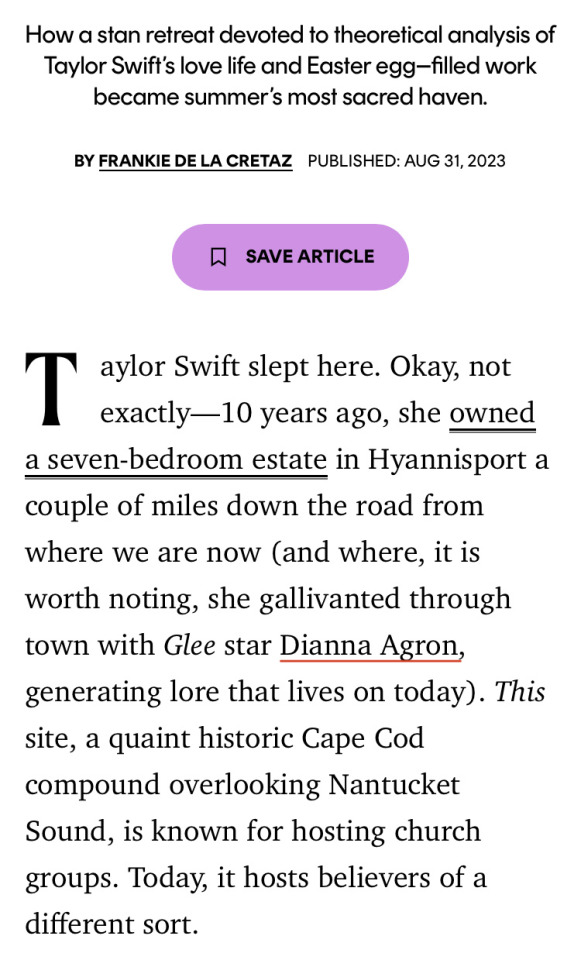



Over the next two days, we’ll be getting into all that and more with hours of presentations and deep-dive analyses. This is set to be a smallish, grassroots-y gathering—only 25 in-person campers are enrolled plus a dozen or so volunteers running the show. Meanwhile, about 300 remote Gaylors have signed up for streaming access to the learning sessions, building on the success of a virtual Gaylor summit that happened last year.
As a Gaylor myself, I’d be here even if Cosmo hadn’t sent me. I introduce myself to campers as we craft cute name tags for ourselves in the lobby of the Craigville Retreat Center. I meet Morgan, 30, who came here from conservative small-town Wisconsin, where she’s been living with her parents due to some unspecified tumult in her life. “I am desperate to be around gay people,” she tells me. When she heard about Camp Gaylore, “I jumped at the opportunity to come here and feel a sense of community.”
Paris, 25, a Boston-based attendee who grew up in Arizona, agrees. “With everything that’s happening legislatively right now, it’s really important to be able to find spaces where you’re able to be with like-minded individuals and feel safe and comfortable expressing yourself.”
Nevada, 25, a newcomer to the Gaylor realm, tells me they were able to attend only thanks to a scholarship the camp offered to defray the $350 tuition cost. “I really thought this was a dreamland that was completely out of reach for me,” they say. Just being here, in congress with others, feels like some kind of miracle.
So maybe I should revise: This weekend is about decoding Taylor Swift songs...but only sort of.
I didn’t travel far to get here, but I’ve come a long way. Four summers ago, I left my marriage to a straight man, right around the time Taylor released Lover. I had a passing familiarity with her oeuvre but didn’t consider myself much of a fan. I was crashing with friends—a lesbian couple—while searching for a new home and striving to create a more openly queer life for myself. With its pastel cover and pro-LGBTQ+ anthem “You Need to Calm Down,” Lover got a ton of airplay in that two-bedroom apartment. And the breakup songs—“Death by a Thousand Cuts,” “I Forgot That You Existed”—certainly spoke to me. But given everything I was going through, Taylor’s music felt like little more than a fluffy distraction.
Jump cut to the following July, when Taylor surprise-released folklore. Every lesbian I knew seemed weirdly excited for this album. With my divorce freshly finalized, I now had the bandwidth to dig in. I discovered Gaylor theories on TikTok and plunged into Taylor’s discography with an eye toward gay themes. For the first time, I listened—really listened—to 2017’s Reputation, an album marketed as Taylor not caring about her press coverage but could just as easily be about a secret queer romance powerful enough to blow up her life. This notion, of hiding in plain sight while inhabiting a straight-presenting persona, resonates deeply for me in queer readings of Taylor’s work.
Here at Camp Gaylore (alternately known as GayloreFest), the analysis is served up with mock-academic gravitas. “We all love to cosplay that we’re professors in this field of Gaylor education,” explains Madyson, 23, a camp co-organizer who hails from New York. To wit, the workshop lineup includes sessions like: “Darling, Everything’s on Fire”: An Exploration of The Hunger Games Through Taylor Swift’s Discography; Unpacking Parasocial Relationships: A Conversation in Favor of Imagination & Community; Friends of Fletcher: Themes in the Music and Visuals of Sapphic Singers & Songwriters; and “Now I’m Your Daisy”: Reimagining The Great Gatsby as Gilded Sapphic Fantasy.
What’s happening here is really nothing new—Gaylors are performing the kind of close reading that happens in pretty much every English lit seminar. For campers like Amanda, 30, a longtime Swiftie who discovered Gaylor theories during the pandemic while awakening to her own queerness, this interpretative exercise is more meaningful than the objective facts of Taylor’s sexuality. “I’m not over here trying to convert people like, ‘Hey, Taylor is gay, and it’s really important to me that you believe that,’” Amanda says. “It’s more about Taylor being this incredible writer who intertwines all these incredible things into her lyrics.”
“We are not the first gaggle of gays to go book a conference center and hang out with each other for a weekend just to talk and gab,” Madyson says. “It just so happens that we all met because Taylor Swift put out some bangin’-ass albums.”
“I don’t even care if she comes out,” Madyson adds. “I actually would prefer she didn’t because I think it’s more fun this way.”
After I check into my single room—a rustic BYO-bed-sheets situation—I return to the common area and settle in for the afternoon’s presentations. Remote presenters will be streaming from all over. A few campers here will be presenting too—streaming from a dedicated quiet room elsewhere on the property. In the common space, all sessions will be projected onto a wall.
And here I have to admit that I end up…not paying much attention to the material. In the best possible way, neither do many of the other campers. I watch as they focus on making friendship bracelets, add artistic flourishes to Gaylor-themed coloring pages, and paint each other’s nails. Chatty groups check in on solo folks: “Are you good by yourself? Would you like to come over here with us?” Sometimes a comfy silence envelops the room. A few campers even nap on couches, the presentation audio forming a sort of pleasant background drone.
This dynamic is striking in its chillness—different from most camps and retreats, where schedules are packed with structured group activities. Kae, a 26-year-old from Saskatoon, Saskatchewan, much prefers the format here. Although Gaylor TikTok was helpful in “expediting” her awareness of her own bisexuality, she finds the noise of social media kind of bad for her mental health. Camp Gaylore feels like the 3D version of a friendly Gaylor group chat she joined on WhatsApp a few months ago, she says. “It’s nice, having a much smaller source of information and also a place where you can just be yourself and be accepted.”
Presentation topics aside, Taylor’s aura at camp is surprisingly scarce. The aesthetic is one of nostalgic/analog summer whimsy. Think: String lights and wildflowers. Salt air and disco balls. Strawberries and rainbow balloons. An activity table set up by camp staffers includes a deck of botanical oracle cards, the social-bonding game We’re Not Really Strangers, and a handful of book selections ranging from Emily Dickinson poems to contemporary works by queer authors like adrienne maree brown.
It’s almost as though the organizers plucked a handful of nice humans off the internet and closed tab on literally everything else, a welcome break. Gaylorism in general is Very Online—born on Tumblr, increasingly huge on TikTok. Along with Madyson, camp co-organizer Katie, 30, recently wrapped a popular Gaylor podcast called The Archers, the duo’s contribution to a booming cottage industry of queer-minded Swiftie content. (Madyson has already launched another pod.) Tess, 30, a London-based camp co-organizer, is a prolific Gaylor creator too. This camp is the group’s way of passing the mic to others to invite their perspectives, to “recognize the brilliance and beauty of our community,” as Tess puts it. There’s even been talk of starting a literary-style magazine that goes beyond Taylor and into the open waters of, well, gay lore. That’s why the camp name has an “e” at the end—an indicator of deeper possibilities.
Gaylor subculture has now gotten big enough to attract coverage from major media outlets, some of it less than favorable—a Salon article last fall compared Gaylors to QAnon. Many face harassment from a hostile cohort of Swifties known as Hetlors, notorious for a queerphobic insistence that Taylor is straight. Bullying from Hetlors has driven some Gaylors to go dark and wipe their social accounts, which explains why most here at Camp Gaylore have asked that Cosmo publish their first names only.
Taylor herself is outspoken in her LGBTQ+ advocacy—granted, as more of an ally. “I didn’t realize until recently that I could advocate for a community that I’m not a part of,” she told Vogue in 2019. But as many Gaylors like to point out, that’s not quite the same as Taylor declaring she’s 100 percent straight and cisgender either. For now, the details of her identity remain anyone’s guess.
“In a cisheteronormative world, we are more likely to assume people to be cis and straight until told otherwise than to assume they’re trans or queer,” says Melissa A. Fabello, PhD, a sex and relationships educator. Her group coaching session this weekend, titled “The Bisexuality Crisis,” will address this very subject.
Camp Gaylore’s idyllic seaside haven is blessedly Hetlor-free. Madyson, who sometimes struggles to socialize in groups, tells me they feel “soothed” mingling on our private stretch of beach. This weekend has always been more about reinforcing the Gaylorverse than dissecting Taylor’s suspected queerness. “It is very much for people to meet and see each other physically and be like, This community is just as real offline as it is online,” Madyson says. In the sand, they spell out GAYLORE in dozens of tiny seashells.
We head to dinner in the large dining hall for a taco buffet—a communal setup that amuses Nevada. “This is so sweet, like the positive parts of going inpatient at the psych ward,” they joke. Then an earnest elaboration: “It’s just nice that other people understand what I’m thinking. I don’t have to explain a million things. I don’t have to be like, Okay, I guess I’ll let you ignore my pronouns. It’s a very good space.”
Afterward, we gather around an outdoor firepit for s’mores and impromptu performances. One camper breaks out an acoustic guitar and shares songs she wrote during a period of homelessness. Her voice is husky and powerful—a howl of survival. A few campers pass around a bong. Inside jokes are hatched. “As cliché as it sounds, I do feel like I’ve known these people forever,” says Lee, 33, a camper from California who credits Gaylor theories with fueling her lesbian awakening seven years ago. For her, this night is “cathartic.”
In the 10 o’clock hour, everyone heads back inside to watch the livestream of the Eras Tour. This has been a ritual for many of us since Taylor hit the road in March. Lots of campers have been tracking the surprise acoustic songs she performs each night—one or two per show, with no repeats from the pre-Midnights archive unless she messes up.
Tonight, Taylor is in Pittsburgh. One member of the Gaylor community—not at camp with us but someone who’s friends with a few campers—has been publicly campaigning for Taylor to play “ME!” at this stop, a track many Gaylors love (see: the big gay energy of its music video). Taylor playing “ME!” would be everything, a definitive acknowledgement of us.
As the livestream plays, campers string together bead bracelets with Gaylor references—the letters “SITBTTEBM” (“She is the best thing that’s ever been mine”), the phrase “WIDE EYED GAYS” (an intentional misspelling of the “All Too Well” lyric). Then the first surprise song begins: It’s “Mr. Perfectly Fine,” off Fearless. Everyone groans. The second song is a miss too: “The Last Time,” from Red. So much for “ME!”
Everyone is super bummed. A few campers even cry a little bit. But there’s beauty in the heartbreak too—something profound and unifying in our shared disappointment. “Even if Taylor were to go away and never do another thing, I feel like we still have this,” Amanda tells me later. “And that’s really cool.”
The big social event of the weekend, on the second and final night, is prom. Given that it’s being held in the retreat’s tabernacle building, camp staffers have printed out a color picture of Jesus, along with big letters that spell out “LYRICS TOO?”—a cheeky nod to the fact that we’re in a house of worship but mostly a deep-cut Gaylor reference (to something once uttered by Taylor’s pal and collaborator Jack Antonoff). A tattooed camp staffer DJs from a heavily stickered laptop, next to a whirling party light that scatters rainbow beams throughout the space.
Many of our prom looks are encoded with Taylor allusions. One camper wears a tiered, ruffled frock in pastel hues, à la Taylor’s Lover era. Another, channeling the Reputation album art, dons a matching corset and skirt in newsprint-pattern fabric. Still another is turned out in the crochet crop tank Taylor wore while promoting Midnights, its colors a near-perfect match for the lesbian pride flag tacked to one wall.
“Cruel Summer”—a Gaylor fave, theoretically chronicling Taylor’s rumored relationship with supermodel Karlie Kloss—blasts from the speakers. The dance floor fills up. We scream-sing the lines about sneaking in through the garden gate, about the shape of a lover’s body being new. As the song reaches its bridge, our collective joy turns incandescent.
“It felt like 70,000 of us in the room,” Lee marvels the next day as campers pack up to leave. “This was the most magical weekend of my summer—and I’ve been to the Eras Tour twice.”
Frankie de la Cretaz is the co-author of Hail Mary: The Rise and Fall of The National Women's Football League. Their work has been featured in The New York Times, The Atlantic, Rolling Stone, and more.
#gaylorefest#gaylor swift x msm#Gaylor swift x mainstream media#Gaylor swift x cosmopolitan magazine#swiftgron#Swiftgron x msm#Swiftgron x mainstream media
17 notes
·
View notes
Text
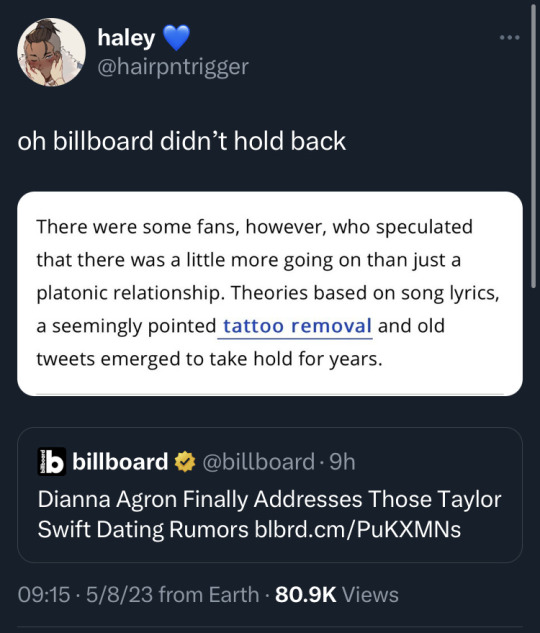

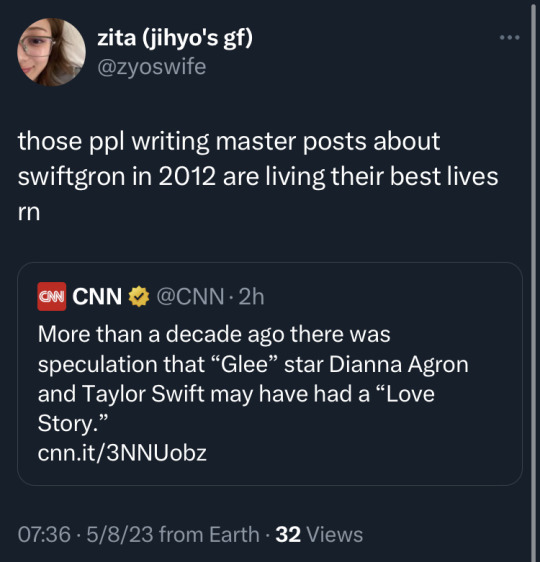
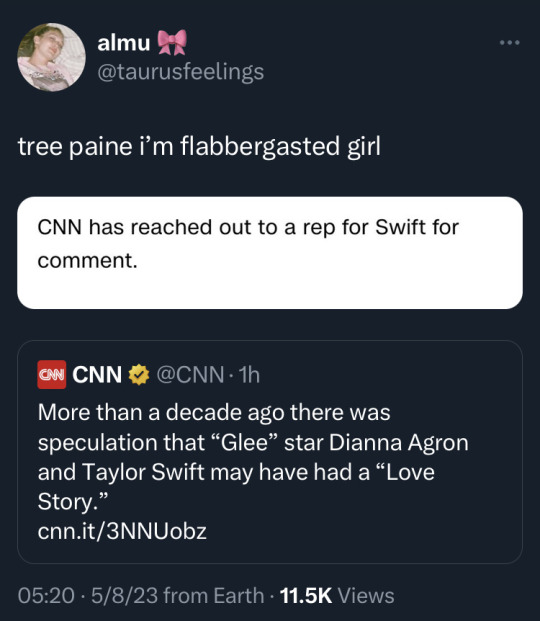
35 notes
·
View notes
Text

Happy Pride!
#Swiftgron 2023#Swiftgron x mainstream media#Swiftgron x cnn#Swiftgron x Rollingstone#dianna agron x gaylor swift
6 notes
·
View notes
Text




7 notes
·
View notes
Text



[Bold Text = Jennyboom21’s emphasis because the wording is interesting]
“Before reading any further, please make sure you have a roll of tin foil and a monocle close at hand—you’ll need them. Supplies secured? Great.”
“Former Taylor Swift Squad member (remember those days?) Dianna Agron recently chatted with Rolling Stone and acknowledged those rumors of a past romance between herself and the illustrious Swift, whose dating life remains an evergreen source of speculation. Is Taylor dating Matty Healy? Maybe yes, maybe no. Did Taylor and Dianna date back in the day? Agron isn’t really saying.”
“When asked about being thanked in the liner notes for Swift’s “22,” one of the singer’s “wait, have you heard of New York? Isn’t it great?”-era songs, Agron shrugged off credit for being an inspiration, saying, “Me? Oh, if only! That’s more because of a friendship than being the inspiration for the song. But I would not be the person to ask about that. I cannot claim that!”
Then this exchange, which closes RS’s Q&A, follows:
How do you feel about the way that friendship was covered in the media? You two were shipped.
Shipped?
You two were made out by the media and some fans to be in a relationship.
That is so interesting. I… I mean, there have been many stories about my dating life that are so wildly untrue. That’s funny.
Elsewhere in the chat, she sidesteps commenting on Glee-related drama and says that maybe someday she’ll tell her own side of things.
“At the end of the day, you can’t control what other people do,” she said. “I’ll leave it for when I write my book at the age of 89. I picture this in Italy. Lunchtime consists of really delicious pastas, dinner consists of really delicious pastas, and I’ll sleep in a little. From 10:45 a.m. to 2:45 p.m. I write. Then I lunch. Then I take a sea dip. Then, from the hours of 5:30 p.m. to 6:30 p.m., I edit what I wrote. And then I do it again.”
We can only hope that somewhere in that pasta haze we get more details about Taylor.
Vanity Fair reached out to representatives for Swift and Agron for comment.
#swiftgronaissance#Swiftgron 2023#gaylor swift x dianna agron#swiftgron x mainstream media#Swiftgron x msm#Swiftgron x vanity fair
15 notes
·
View notes
Text

+ “Rolling Stone dropped a new profile/interview with Dianna Agron in which she is pretending not to know what the word “shipping” means in relation to fandom, despite the fact that she was one-half of Faberry, the femslash ship that kept Tumblr running for about five entire years between 2009-2014. (That’s Rachel Berry and Quinn Fabray from Glee, in case you’re one of the lucky ones who never watched that disasterpiece.) This time, though, “shipping” is in reference to Dianna’s friendship/girlfriend conspiracies with Taylor Swift and the rumors that she inspired the song “22” due to the fact that she’s mentioned in the liner notes. “Me? Oh, if only!” she said before clarifying: “I … I mean, there have been many stories about my dating life that are so wildly untrue… That’s funny.” Look, would you kiss her on the porch in front of all your stupid friends or not, Dianna? Answer me! “
#swiftgron#swiftgronaissance#swiftgron 2023#swiftgron x mainstream media#gaylor swift x dianna agron
12 notes
·
View notes
Text
💭💭💭
One of these things is not like the other 🍿
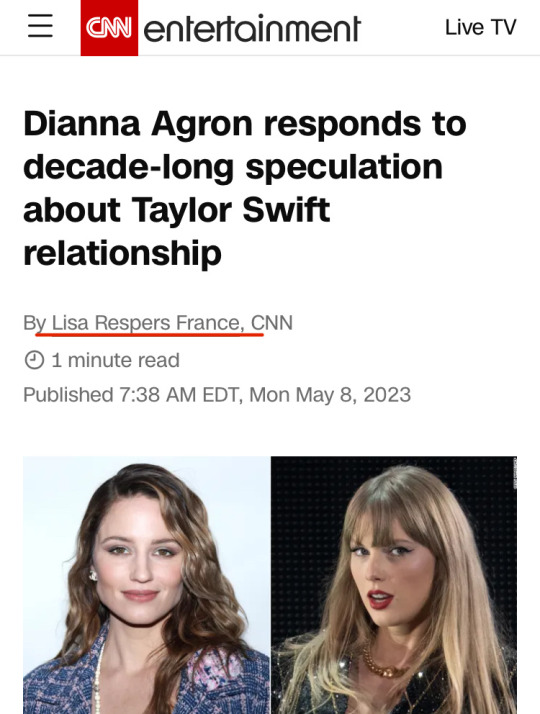
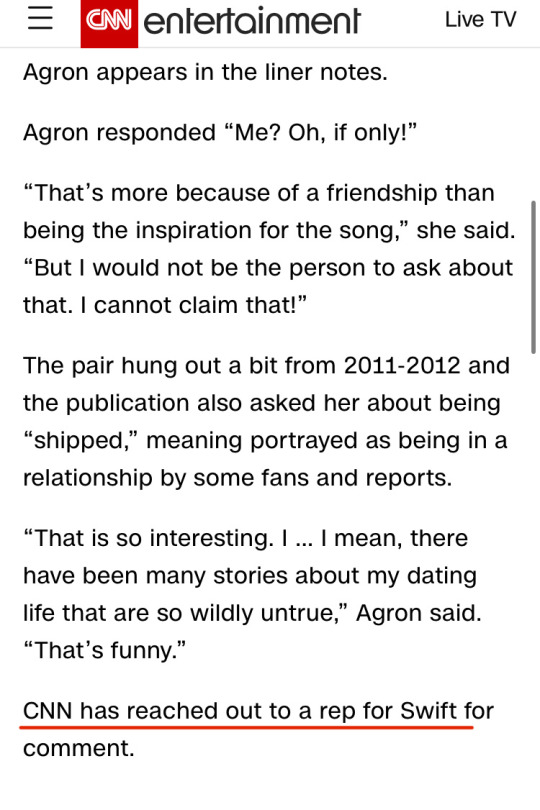
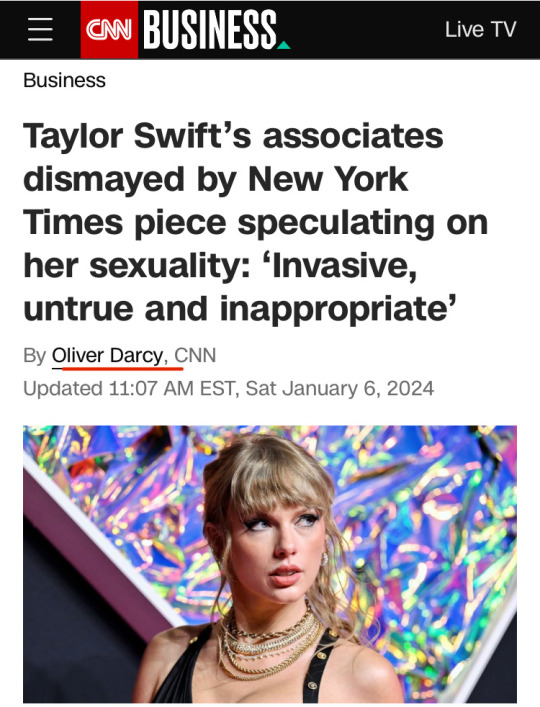
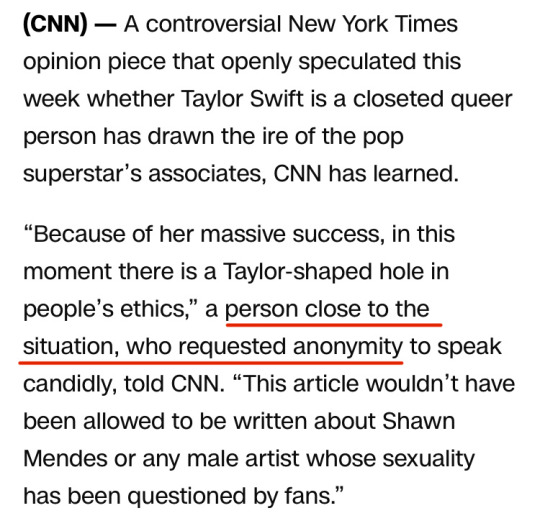

#mainstream media x gaylor swift#gaylor swift x cnn#gaylor swift x the 2024 nyt article#Swiftgron 2023 x cnn#Oliver vs Lisa
5 notes
·
View notes
Text
Today in ‘Everybody Knows: Swiftgron Edition’…


👀📝📝📝
#Gaylor swift x mainstream media#swiftgron x mainstream media#Swiftgron x vulture#gaylor swift x dianna agron
10 notes
·
View notes
Text


They never go out of “Style” 👀🍿🍿🍿

10 notes
·
View notes

